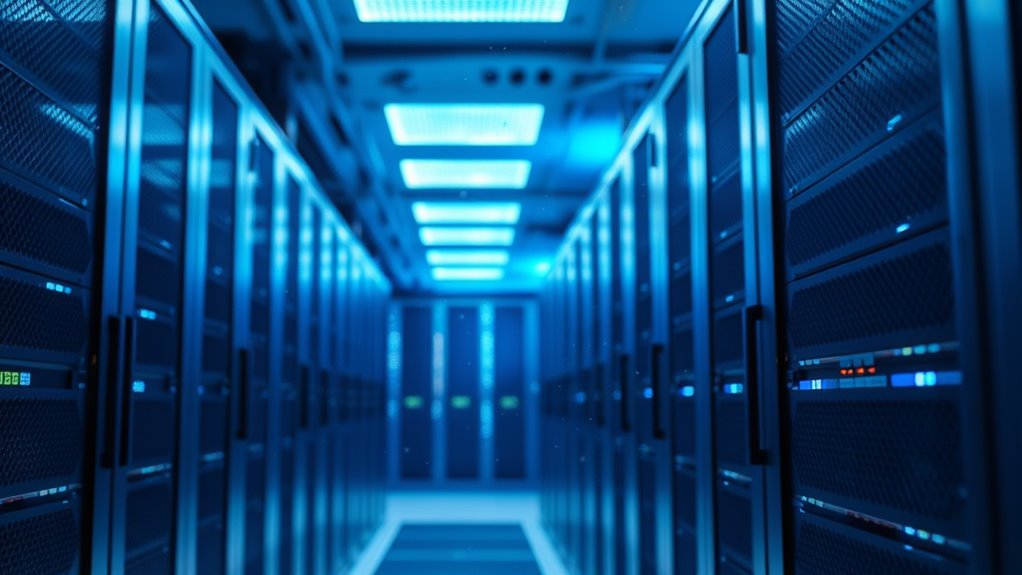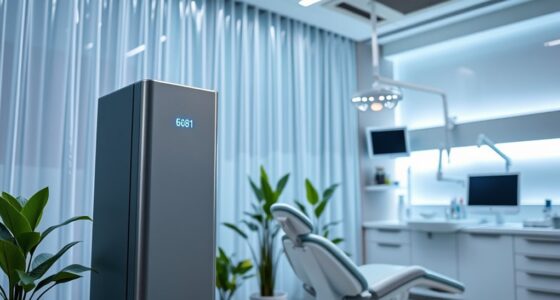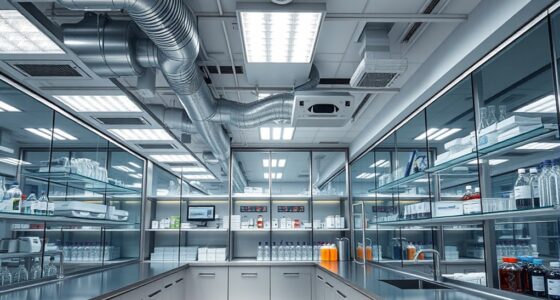To manage dust and optimize cooling in data centers, you should use effective air purification systems that include high-efficiency filters like HEPA to trap tiny particles. Regular maintenance, such as replacing filters on schedule, keeps airflow unobstructed and prevents dust buildup. Controlling humidity and sealing environments further reduce contaminants. Implementing these strategies ensures your equipment stays cool and reliable. Keep exploring how to enhance your system’s efficiency and protect your critical hardware.
Key Takeaways
- Implement high-efficiency filtration systems, like HEPA filters, to trap microscopic dust and pollutants before they reach sensitive equipment.
- Maintain proper humidity levels and sealed environments to prevent external contaminants from entering the data center.
- Regularly inspect, clean, and replace filters to ensure optimal airflow and filtration performance.
- Use negative pressure zones to prevent unfiltered outside air from infiltrating the data center environment.
- Proper airflow management and cooling strategies, combined with effective dust filtration, prolong equipment lifespan and prevent overheating.

Have you ever wondered how data centers keep their equipment cool and free from harmful contaminants? The secret lies in managing indoor air quality meticulously. Since data centers house sensitive electronic equipment that generates significant heat, maintaining an ideal environment is essential. Proper cooling systems are essential, but equally important is ensuring that the air inside remains clean and free from dust and other particles that could cause malfunctions or reduce equipment lifespan. Dust filtration becomes a critical component of this process.
Dust particles, though tiny, can accumulate rapidly in a data center, settling on servers, cooling units, and other hardware. Over time, this buildup can obstruct airflow, impede cooling efficiency, and even lead to overheating. To prevent these issues, advanced dust filtration systems are installed to trap airborne particles before they settle on critical equipment. These filters are designed to capture a broad spectrum of contaminants, including microscopic dust, lint, and other pollutants, thereby preserving the integrity of the indoor air quality. High-efficiency particulate air (HEPA) filters are often employed because of their ability to trap very small particles, ensuring that the air circulating within the data center remains as clean as possible.
You might notice that maintaining ideal indoor air quality isn’t just about filtering dust; it also involves controlling humidity levels and preventing the ingress of pollutants from outside. Many data centers implement sealed environments with controlled ventilation systems that incorporate multiple stages of filtration. These systems continuously scrub the incoming air, removing particulates and other contaminants before they reach sensitive hardware. This approach helps sustain a stable, clean environment, which is fundamental for reliable operation.
Additionally, regular maintenance of filtration systems is essential. Filters need to be checked and replaced according to manufacturer specifications to ensure they perform effectively. Filters that are neglected can become clogged, restricting airflow and diminishing the effectiveness of dust filtration. Some data centers also use negative pressure environments, which prevent unfiltered outside air from entering, further enhancing indoor air quality. Moreover, understanding the dust filtration process helps optimize cooling efficiency and prolong equipment lifespan.
In essence, managing indoor air quality through effective dust filtration is a frontline defense against hardware failures and downtime. It’s a proactive approach that keeps equipment cool, prevents overheating, and extends the lifespan of critical components. By investing in high-quality filtration systems and diligent maintenance, you ensure that your data center remains a resilient, efficient hub that operates smoothly and securely.
Frequently Asked Questions
How Often Should Air Filters Be Replaced in Data Centers?
You should replace air filters in your data center every three to six months, depending on your filter maintenance and the environment’s dust levels. Regularly checking your filters helps guarantee ideal airflow and cooling efficiency. Follow your manufacturer’s replacement schedule and monitor for signs of clogging or reduced airflow. Staying on top of your filter maintenance minimizes dust buildup, keeps equipment cool, and prevents potential overheating issues.
What Are the Best Air Purification Technologies for Dust Removal?
Think of your data center’s air as a battlefield, where dust is the enemy. HEPA filtration acts like a mighty sieve, trapping tiny particles with high precision. Electrostatic precipitators charge dust particles, pulling them out of the air like magnets. These technologies work together to keep dust at bay, ensuring ideal cooling and equipment longevity. You should choose systems combining HEPA filters and electrostatic precipitators for maximum dust removal efficiency.
How Does Humidity Affect Air Quality Management in Data Centers?
Humidity control is vital because moisture impact can cause corrosion, mold growth, and static electricity, which threaten data center equipment. Maintaining ideal humidity levels—around 45-50%—helps you prevent these issues. Too much humidity increases the risk of electrical shorts, while too little causes static buildup. By actively managing humidity, you guarantee a stable environment, improve air quality, and protect your sensitive hardware from moisture-related damage.
Can Air Purification Systems Improve Cooling Efficiency?
Yes, air purification systems can improve cooling efficiency by enhancing airflow enhancement and dust particle capture. When these systems remove dust and debris, they prevent airflow blockages that hinder cooling performance. As a result, your data center maintains ideal temperatures, reduces equipment overheating risks, and operates more efficiently. Proper air purification guarantees clean, well-ventilated environments, directly contributing to better cooling and overall system reliability.
What Are the Costs Associated With Implementing Air Purification Solutions?
Have you considered how much implementing air purification solutions costs? The expenses include equipment, installation, and ongoing maintenance, which can vary based on your data center’s size and needs. Conducting a thorough cost analysis helps you understand the budget considerations involved. While initial costs might seem high, improved air quality can lead to better equipment performance and energy efficiency, ultimately saving you money in the long run.
Conclusion
So, next time you marvel at your shiny data center, just remember it’s secretly battling dust villains and rogue particles to keep your precious data safe. Without proper air purification, your servers are basically inviting a dust storm to throw a party. Think of it as a spa day for your tech—if you want your servers to keep running smoothly, maybe invest in some clean air, or risk turning your high-tech haven into a dusty disaster zone.









